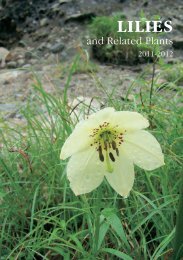LILIES - RHS Lily Group
LILIES - RHS Lily Group
LILIES - RHS Lily Group
You also want an ePaper? Increase the reach of your titles
YUMPU automatically turns print PDFs into web optimized ePapers that Google loves.
The natural distribution of Lilium candidum is probably Greece (maybe<br />
extending somewhat further north in the Balkan Peninsula), SW and S Anatolia,<br />
Syria, Lebanon and Palestine (see pp. 25). It is found in macchie, phrygana and<br />
on rock ledges, often on limestone and generally at altitudes of 100-1200m,<br />
flowering in May and early June.<br />
For several reports of Lilium candidum it is difficult to assess whether they<br />
refer to native or naturalised plants. It is not unusual to see the species in the<br />
outskirts of villages where it clearly subsists from former cultivation, but there<br />
are also populations that appear to be wild. I have seen it on rock ledges rather<br />
far from habitations, e.g., NW of the village of Driopi in NE Peloponnese and on<br />
Mt Orliakas in northern Pindos. A large population grows in phrygana by Pirgos<br />
Dirou in the Mani Peninsula (S Peloponnese), and there are also reports from<br />
Monemvassia and Mt Arachneo. In north central and north western Greece there<br />
appear to be native populations at least on Mt Vourinos, near Konitsa and near<br />
Kastoria. Native status on the Aegean islands is more doubtful.<br />
Lilium candidum is easily recognised on the large, snow-white flowers which<br />
are generally borne 5-9 in a short raceme. The tepals are only slightly recurved.<br />
Sfikas (Fisis 42: 31, 1988) has pointed out that cultivated Greek plants tend<br />
to be taller and stouter than the wild ones with basal leaves appearing in the<br />
autumn rather than in the spring. With such a long history of cultivation there<br />
has undoubtedly been some selection, and a detailed study of variation in Greece<br />
and elsewhere in the presumably native area would be of interest.<br />
3. Lilium martagon<br />
It cannot be established with certainty whether the Martagon <strong>Lily</strong> was known to<br />
the ancient authors. In his book Paradisus Terrestris (1629) the London apothecary<br />
John Parkinson undoubtedly refers to Lilium martagon when speaking about<br />
“those kindes of Lillies, which carry diuers circles of greene leaues set together<br />
at certaine distances, round about the stalke”. In Germany where the species<br />
is native it was mentioned by Leonhart Fuchs (1542) and possibly earlier. In<br />
Denmark and southern Sweden it is known in cultivation at least since the late<br />
seventeeth century, having probably been introduced from central European<br />
stock and now naturalised, sometimes in large quantity, in old parks around<br />
mansion houses. In modern times it has become a well known garden plant with<br />
several commercial varieties.<br />
In Greece the distribution of Lilium martagon follows the mountains<br />
southwards to Parnassos in Sterea Ellas (see pp. 24). This is part of a large total<br />
range extending from Spain and France to western Siberia. In Greece it is a<br />
species of somewhat damp, semi-shaded places in deciduous woods, bracken<br />
thickets and meadows, generally between 700 and 1800 m, flowering from mid-<br />
22




